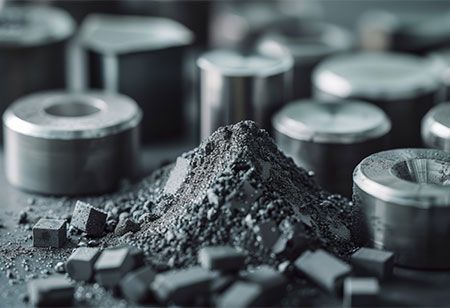
The demand for intricate metal components with exceptional precision and performance is soaring in manufacturing. Traditional manufacturing me- thods often fall short in meeting these stringent requirements. Fortunately, a revolutionary solution has emerged: powdered metal.
That said, this article will explore the benefits of powdered metal and how it can revolutionize your manufacturing processes.
Powdered metal refers to metal that has been processed into a fine granular form, often resembling a powder. Depending on the desired properties and application, this material is created through various methods, such as atomization, chemical reduction, or mechanical grinding. Once produced, the powdered metal can be used in advanced manufacturing techniques like powder metallurgy or 3D printing to create a wide range of parts and products.
 Benefits of Powdered Metal in Manufacturing
Benefits of Powdered Metal in Manufacturing Powdered metal has revolutionized the manufacturing landscape, offering a range of advantages that make it a preferred choice for creating high-performance and cost-effective components. Below is an in-depth exploration of its key benefits:
Powdered metal processes are inherently cost-efficient due to their ability to minimize waste and optimize material usage. Unlike traditional manufacturing methods, such as machining, which often involve cutting away large portions of material and generating significant scrap, powdered metal processes like powder metallurgy use only the exact amount of material needed to create the part. This not only reduces raw material costs but also lowers expenses related to handling and disposing of scrap.
One of the standout features of powdered metal is its ability to blend different types of metal powders to form unique alloys. This material versatility allows manufacturers to create parts with customized properties tailored to specific applications. This flexibility makes powdered metal suitable for various industries, from automotive to aerospace and medical devices, where specific material characteristics are often essential. Additionally, the process can incorporate rare or high-performance materials requiring more work to utilize efficiently using conventional methods.
A defining advantage of powdered metal is its ability to create intricate and complex geometries. Traditional manufacturing methods often struggle with producing components with internal channels, fine details, or non-linear shapes. Powder metallurgy and metal additive manufacturing techniques overcome these limitations by enabling the design and production of highly complex parts directly from powdered metal. This allows for innovative features like porous structures for filtration systems or lightweight designs for aerospace applications.
Powdered metal processes boast an exceptionally high material utilization, often approaching 100%. This starkly contrasts with machining, where much of the raw material ends up as scrap. The near-complete conversion of powder into usable parts saves costs and is particularly beneficial for expensive or rare materials, such as titanium or precious metal alloys. Moreover, scrap generated during powdered metal production can frequently be recycled and reused, improving material efficiency.
Parts made using powdered metal processes exhibit a high degree of consistency and dimensional precision, thanks to the controlled nature of the manufacturing techniques. The uniformity in particle size and composition of the metal powders ensures that the final product has predictable and reliable mechanical properties. Modern powder metallurgy and sintering methods also allow for tight tolerances, producing parts that require little or no finishing.
The manufacturing processes used with powdered metal, such as sintering and compaction, produce parts with excellent mechanical properties. Depending on the specific powder blend and processing techniques, these properties can include high strength, durability, wear resistance, and heat resistance. Sintering creates strong bonds between the particles, producing dense, robust parts that can withstand demanding operational conditions. This makes powdered metal components ideal for applications like gears, bearings, and cutting tools, which require exceptional strength and longevity under high stress.
Powdered metal processes are among the most environmentally friendly manufacturing methods available today. They consume significantly less energy than traditional processes like casting, forging, or machining. Moreover, the minimal material waste generated aligns with sustainability goals by reducing the environmental footprint of production. Many powdered metal applications also incorporate recycled materials, further promoting eco-friendliness. This green approach is increasingly important as industries strive to meet stricter environmental regulations and appeal to environmentally conscious consumers.
Powdered metal manufacturing offers unmatched scalability, making it suitable for low-volume custom and high-volume mass manufacturing. This flexibility allows manufacturers to address various market demands, from prototypes and specialized components to millions of identical parts for large-scale applications like automotive engines. The ability to scale production without compromising quality or efficiency makes powdered metal a versatile solution for industries with dynamic production requirements.
One significant advantage of powdered metal manufacturing is its ability to produce parts in a near-net shape, meaning that they closely resemble the final desired dimensions and geometry. This minimizes or eliminates the need for secondary machining, grinding, or other finishing processes, which can be costly and time-consuming. By reducing post-processing requirements, manufacturers can streamline production workflows, save labor costs, and deliver products faster. This is particularly beneficial in industries where speed and efficiency are critical to maintaining a competitive edge.
Powdered metal's combination of efficiency, versatility, and precision makes it a valuable resource in modern manufacturing and drives innovation across various industries.
Powdered metal technology continues to evolve, offering manufacturers a wide range of benefits. From improved mechanical properties and enhanced design flexibility to reduced material waste and energy consumption, this innovative technique is poised to shape the future of manufacturing. By embracing powdered metal, businesses can optimize production processes, reduce costs, and deliver superior products.
We use cookies to ensure you get the best experience on our website. Read more...